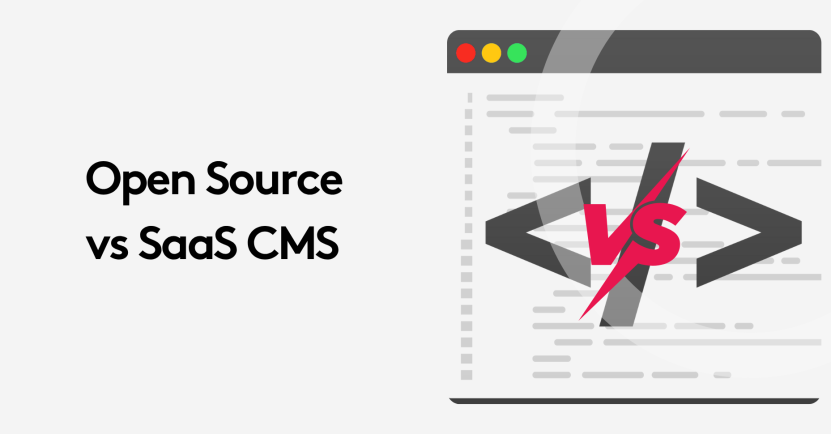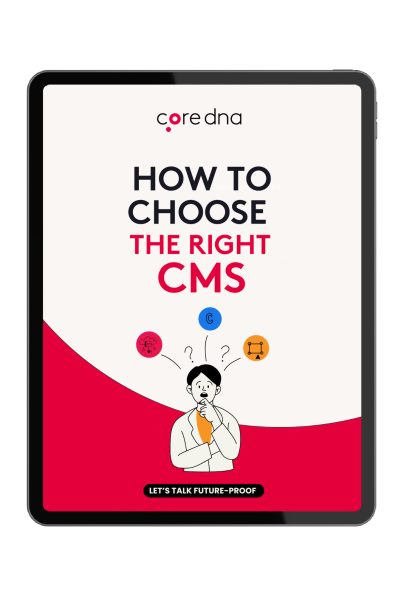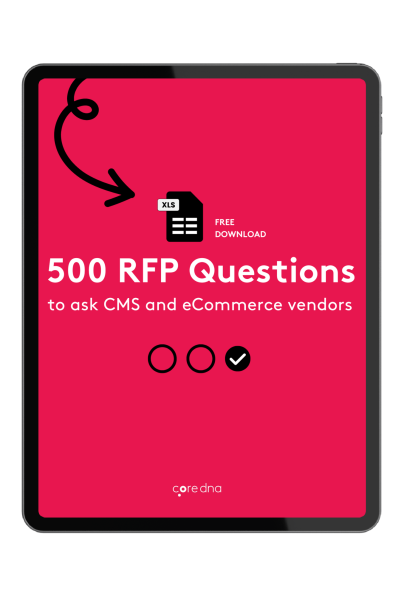Which one to choose: Open-Source CMS vs SaaS CMS

If you are currently evaluating CMSs for your business, know that it's about more than just licensing. it’s a strategic decision that shapes your budget, your team’s workflow, and the speed at which you can deliver content.
While open-source platforms like WordPress, Drupal, Joomla! and Ghost champion “free” software, there is no such things as a free lunch. The costs of major-version migrations, hosting, security patches and plugin maintenance can quickly eclipse any upfront savings.
In contrast, SaaS solutions wrap hosting, updates, support and new features into a predictable subscription, often yielding a lower total cost of ownership for content-driven sites.
In this article, we'll compare open-source and SaaS CMS options, comparing their capabilities, upgrade rhythms and end-to-end costs to help you choose the model that best fits your business.
Key takeaways
- If Open-source CMSs eliminate license fees they incur variable costs: major upgrades, hosting, maintenance, security patches, and plugins, that can total tens to hundreds of thousands over time.
- SaaS turns migration projects and unexpected bills into a steady subscription, while open-source often has large one-off migration fees every 1–2 years.
- Small-business open-source setups run roughly $11K–$52K over four years (enterprises $90K–$360K+), versus $38K for a mid-market SaaS plan.
- Go open-source if you need deep customization, full code control, and have in-house or agency DevOps to manage cost spikes.
- Choose SaaS for rapid launches, predictable Opex, and fully managed hosting, security, and upgrades.
On this page:
What is an Open-Source CMS?
When people refer to open-source software, they usually mean a platform with a source code that is free and available for anyone to use, modify and distribute.
Most open-source platform usually boast a large community that helps maintain and develop the platform. While the licensing is free, to make open-source work for your business, you will need plugins and developers to create your customized sites. The most popular platforms don't need introducing: WordPress, Drupal, Joomla!, and Ghost.
At the core of any open-source CMS is its global developer community. Thousands of contributors around the world continuously add features, resolve bugs and publish security patches—so you benefit from a rich library of themes and plugins without waiting on a single vendor.
You also have full control over hosting. Whether you choose a budget-friendly shared server, a dedicated VPS or your own data center, you decide how the platform performs, which compliance measures to enforce and how it integrates with the rest of your stack.
Perhaps the biggest advantage is customization freedom. With the source code in your hands, you can build custom modules, tailor every template and connect the CMS to virtually any external system, no “approved” extension marketplace required.
That level of control, however, comes with its own responsibilities. You (or the agency you hire) must set up and maintain your servers, apply ongoing security updates and plan for each major-version migration. Every plugin, hosting change or upgrade project carries its own cost, and those expenses can vary unexpectedly.
By weighing this hands-on maintenance and variable budget against the flexibility you gain, you’ll know whether an open-source CMS is the right fit for your team’s skills and financial plan.
Comparing Open-source CMS platforms
Below is a quick overview to set the stage: we’ve lined up the four most popular open-source CMSs side-by-side: WordPress, Drupal, Joomla! and Ghost. You can instantly compare their market share, tech stack, licensing, usability, extensibility, performance, security posture and ideal use cases.
Use this snapshot to see at a glance which platform best fits your team’s skillset and project requirements before diving into the detailed feature breakdowns.
Popular Open-Source CMS Comparative Table
Feature | WordPress | Drupal | Joomla | Ghost |
|---|---|---|---|---|
Market Share | 62.7 % | ~1.2 % of all sites | 1.72 % | 0.1 % |
Language | PHP | PHP (Symfony) | PHP (MVC) | JavaScript (Node.js) |
License | GPL v2+ | GPL 2+ | GPL 2+ | MIT |
Ease of Use | High | Medium | Medium | High |
Extensibility | Very High | Very High | High | Medium |
Performance | Variable (caching needed) | High | High | Very High |
Security | Varies (many plugins) | Excellent | Good | Good |
Ideal Use Cases | Blogs, SMB sites, e-commerce | Enterprise, complex portals | Community portals, mid-level CMS | Publishing, memberships |
Comparing the most popular Open-source CMS platforms
WordPress
WordPress is undoubtedly the world’s most popular open-source CMS, powering over 40 % of websites. It’s licensed under GPLv2, written in PHP, and backed by a vast ecosystem of more than 58,000 plugins and thousands of themes.
Pros: intuitive for non-technical users, extremely extensible, huge community support.
Cons: frequent target for security attacks, can slow down without proper caching and optimization.
Drupal
Drupal is a robust PHP framework under GPL 2+ that drives about 14 % of the top 10,000 sites. Its modular architecture and API-first design make it ideal for complex data models and high-traffic applications.
Pros: built for scalability and flexibility, strong security record, enterprise-grade features like granular permissions and built-in multilingual support.
Cons: steep learning curve, major upgrades require dedicated development sprints.
Joomla
Joomla combines a PHP MVC framework with a solid balance of built-in features and extensibility, powering roughly 1.7 % of the web. It ships with core support for multilingual sites, access control lists and caching.
Pros: rich out-of-the-box functionality, more flexible than WordPress yet simpler than Drupal, active community documentation.
Cons: smaller extension library than WordPress, security updates arrive less often.
Ghost
Ghost is a modern, Node.js-based CMS released under the MIT license, favored by publishers and membership sites. It delivers speed and a content-first editing experience with native Markdown support and a clean API.
Pros: high performance, built-in membership and subscription tools, headless-friendly REST and GraphQL APIs.
Cons: narrower focus on publishing so fewer plugins, smaller community compared to PHP-based CMSs.
The Cost of Open-Source CMS
We often associate “open source,” to the word “free”. But behind that free license lies a cascade of costs that tend to catch decision makers off guard. Every major version upgrade, from one numbered release to the next, becomes a planned project.
Budgeting for Open-Source CMS: Small Business to Enterprise
Platform | Small Biz Initial Build | Small Biz Annual Maintenance | 4-Year TCO (SB) | Enterprise Initial Build | Enterprise Annual Maintenance | 4-Year TCO (ENT) |
|---|---|---|---|---|---|---|
WordPress | $100 – $3,000 | $75 – $10,000 | $5,000 – $15,000 | $25,000 + | $10,000 – $20,000 | $65,000 – $180,000 |
Drupal | $5,000 – $20,000 | $2,000 – $5,000 | $15,000 – $40,000 | $50,000 – $200,000 + | $10,000 – $30,000 | $90,000 – $320,000 |
Joomla | $2,000 – $3,000 | $1,000 – $1,500 | $6,000 – $8,000 | $15,000 – $50,000 | $5,000 – $10,000 | $35,000 – $90,000 |
Ghost | $2,000 – $5,000 (setup) + $10 – $20/mo hosting | $500 – $1,000 | $4,000 – $10,000 | $5,000 – $10,000 (custom theming) + $2,000 – $3,000/yr maintenance | $2,000 – $3,000 | $13,000 – $25,000 |
Open-source CMS Major-Version Migration Fees
When you choose an open-source CMS, you need to plan for major-version migrations on a cadence dictated by each project’s release cycle. Here’s a quick look at how often you’ll need to budget for, and execute, those “big jump” upgrades.
Platforms like WordPress may roll out significant updates three to four times a year, and Drupal every couple of years, but almost every modern CMS follows a similar cadence. Each jump forces you into a cycle of database migrations, compatibility testing, theme or plugin refactoring, and QA sign-off.
Even a seemingly simple migration can require a week or more of developer time, and that time is billed at market rates, often starting in the low thousands and climbing sharply for enterprise-scale sites.
Beyond the obvious migration fees, you also absorb ongoing maintenance and security overhead. An open-source CMS doesn’t come with a safety net: you’re on the hook for hosting costs, load-balancer configuration, performance tuning, automated backups, and 24/7 monitoring.
Then there’s the ecosystem of plugins and extensions. And even when a plugin itself is free, every update cycle carries the risk of compatibility conflicts that must be diagnosed and resolved by a developer.
Before you know it, that “free” foundation has layers of premium licenses, custom code patches, and troubleshooting time all adding to your bottom line.
Platform | Major-Release Cadence | Recommended Migration Frequency | Estimated Migration Cost |
|---|---|---|---|
Joomla! | Every 2 years (odd-year October releases) | Plan migrations every 2 years | $5,000 – $40,000 per event |
Drupal | Every 2 years (even-year releases) | Plan migrations every 2 years | $15,000 – $50,000 per event |
WordPress | 1 major release per year (as of 2025) | Upgrade within 6 months of each release | $2,000 – $20,000 per event |
Ghost | Continuous, with minor version auto-applied | No manual migrations, updates auto-deployed | $0 – $1,000 (self-hosted; hosted plans handle it) |
What Is a SaaS CMS?
A SaaS (Software-as-a-Service) CMS is a cloud-hosted content management system delivered on a subscription basis. Instead of installing and managing software on your own servers, you access the CMS through a web browser, your vendor handles hosting, infrastructure, security, backups, and continuous updates.
Key Characteristics of Saas CMS
With a SaaS CMS you pay a single monthly or annual subscription that covers the software license, hosting and support, eliminating separate invoices for each component.
Updates happen automatically in the background, so new features, performance improvements and security patches arrive without you having to schedule a migration project.
The platform runs on a shared, multi-tenant infrastructure, which lowers costs and ensures every customer benefits from ongoing enhancements. Your provider also manages all operational details, from DevOps pipelines to compliance certifications such as SOC 2 and GDPR, backed by guaranteed uptime commitments.
Core Benefits of SaaS CMS
A SaaS subscription brings predictable budgeting by replacing large one-off expenses, like hardware purchases or agency upgrade fees—with a steady operating cost.
You gain the ability to launch new sites or deploy features in a matter of minutes rather than weeks, since the vendor takes care of infrastructure setup and maintenance.
The underlying cloud environment and global content delivery network automatically scale to handle traffic surges, sparing your team from complex performance tuning. Everything you need, hosting, security, analytics, support and even add-on modules for ecommerce or personalization is bundled into one service.
Trade-Offs to Consider
Because you do not have direct access to the core application code, customization is limited to the APIs, plugins or theming options the vendor provides. If you ever decide to move to another platform, migrating content and integrations can require significant work.
Finally, some advanced feature, such as enterprise-grade service level agreements or AI-powered personalization, may only be available on higher-tier plans, which can affect your overall budget.
By shifting infrastructure and maintenance responsibilities to the vendor, a SaaS CMS frees your team to focus on content strategy and user experience—trading deep technical control for simplicity, speed, and cost certainty.
Saas CMS: Bundled and Predictable
Contrast all that with a modern SaaS CMS, where you trade variable, hard-to-predict line items for a clean, all-in-one subscription that covers hosting, security, backups, and support.
What you gain in predictability you often lose in hands-on control, but for many teams, that’s a welcome trade-off: you no longer have to assemble hosting environments, configure firewalls, or deploy patches.
Below is a side-by-side comparison of Core dna alongside seven leading SaaS CMS platform, including Contenstack and Sitecore XM Cloud so you can quickly gauge differences in pricing, hosting, upgrade cadence, e-commerce support, API/headless capabilities, personalization/orchestration features, and support models.
SaaS CMS: Core dna vs Leading Platforms
| Feature | Core dna | Contentful | Contentstack | HubSpot CMS | Sitecore XM Cloud |
|---|---|---|---|---|---|
| Pricing | Custom enterprise pricing | Free tier; $300 /mo (Lite); Premium & Enterprise custom pricing | $995 /mo per user; custom enterprise | Free; $20 /mo (Starter); $500 /mo (Professional); $1,500 /mo (Enterprise) | Usage-based; varies by unique sessions, modules & environments |
| Hosting & Infra | Included (multi-site, CDN, auto-scaling) | Included (CDN, global edge delivery) | Included (multi-cloud, 99.99 % HA) | Included (premium hosting, SSL, CDN) | Included (enterprise-grade DXP, global CDN, compliance certifications) |
| Major Migrations | None, continuous updates, no versions | None, automatic, backward-compatible releases | None, continuous feature rollouts | None, continuous platform updates | None, continuous delivery |
| eCommerce Support | Native eCommerce module (catalog, promotions, orders) | Via third-party integrations (Shopify, Commerce Layer) | Via Digital Commerce hub (MACH integrations) | Built-in eCommerce tools through CRM + CMS | Via OrderCloud, Commerce Services add-ons |
| API / Headless | Hybrid CMS: full REST & GraphQL APIs | API-first: REST & GraphQL, SDKs in multiple languages | MACH-certified headless CMS with full API coverage | Headless via CMS Content API | Composable & API-first architecture: REST, GraphQL, integration frameworks |
| Personalization & Orchestration | AI Assistant, low-code workflows, personalization engine | Limited native; relies on external personalization/CDP integrations | Built-in personalization & automation hub | Dynamic content & smart rules via Marketing Hub | AI-powered personalization, analytics & A/B testing within XM Cloud |
| Support & SLA | 24/7 help desk, dedicated CSM, enterprise SLAs | Community support + paid SLAs on Enterprise plans | 24/7 support, TAM, migration guidance | Community + standard support; premium SLAs on Enterprise tier | Enterprise SLAs, 24/7 global support, dedicated technical account management |
With a SaaS CMS, you swap the variable, project-based expenses of open-source for a steady subscription that bundles hosting, security, support, and feature updates. There are no discrete “major migration” projects—new versions roll out automatically, and your team never pauses for upgrades.
- Subscription Licensing: You pay a flat monthly fee (e.g. $200–$2,000/month depending on tier).
- All-Inclusive Services: Hosting, backups, SSL, performance tuning, security patches, and support come in one package.
- Continuous Delivery: Both minor tweaks and major feature releases deploy to all customers instantly—no extra invoices or agency tickets.
- Scalability & SLAs: Traffic spikes and compliance needs are handled by the vendor under guaranteed uptime and certifications.
The Total Cost of Ownership: Open-Source CMS vs SaaS CMS
When it comes to choosing a CMS, the price tag is just the beginning.
Open-source platforms may seem free at first glance, but when you factor in development hours, hosting, security updates and those one-off upgrade projects, the costs add up quickly.
SaaS solutions, on the other hand, consolidate hosting, maintenance, security and feature roll-outs into a single subscription. In this section, we’ll lay out the full spectrum of expenses for both models so you can see which approach aligns best with your budget and operational style.
Comparative Snapshot: Open-Source CMS vs. SaaS CMS
Category | Open-Source CMS | SaaS CMS |
License Fee | Free (GPL, MIT, etc.) | Included in subscription |
Initial Agency Setup | $3K–$20K (design, development, launch) | $0 |
Annual Maintenance | $2K–$8K (security patches, minor upgrades) | Included |
Major Migrations | $5K–$25K every 1–2 years | None |
Hosting & Infrastructure | $2K–$8K/year (VPS, DevOps, CDNs) | Included |
Security & Compliance | Agency-managed, variable cost | Auto-patched, SLAs, certifications |
Support Model | Hourly agency or in-house IT | 24/7 vendor help desk and account manager |
4-Year Total Cost of Ownership | $11K–$52K (small biz) or $90K–$200K (enterprise) | on average $38.4K |
Budget Predictability | Low capex spikes around migrations | High, even cash-flow, pure opex |
Upfront Licensing vs Predictable Subscription
Open-source licensing appears cost-free, but you shoulder all hosting, support, and upgrade expenses independently. In contrast, a SaaS subscription might start higher yet, it bundles hosting, automatic security patching, support SLAs, and infrastructure at no extra charge.
Continuous Updates vs Periodic Migrations
SaaS platforms deliver new features and security patches to all customers simultaneously, removing the need for separate upgrade projects. You avoid disruptive, costly migrations that can stall marketing campaigns and drain dev resource.
SaaS pricing models let you align costs with actual usage and growth, rather than budgeting for unpredictable, large-scale migrations .
Long-Term Scalability and Vendor Support
With open-source, you’re responsible for troubleshooting, patch management, and scaling infrastructure.
SaaS vendors handle performance tuning, uptime guarantees, and compliance certifications (e.g., SOC 2, GDPR), translating into fewer in-house headcount needs and lower risk.
Total cost of ownership isn’t just about dollars, it reflects how you want to run your business. If your team thrives on hands-on control and deep customization, open source gives you that freedom at the price of ongoing maintenance and upgrade planning.
If you’d rather trade that hands-on work for predictable expenses and turnkey operations, a SaaS CMS may be the smarter long-term investment. Armed with this clear cost comparison, you can make a decision that supports your growth, your resources and your peace of mind.
Conclusion
At the end of the day, there is no one “best” CMS, only the one that fits your team, your budget and your long-term goals.
If you have developers ready to roll up their sleeves, relish full control over code and infrastructure, and can plan for periodic upgrade projects, an open-source CMS will reward you with unmatched flexibility.
If you’d rather hand off hosting, maintenance and security to a vendor, lock in predictable operating expenses and focus on writing and design instead of server logs and patch schedules, a SaaS solution is likely a better match.
Whichever path you choose, understanding the true costs will help you avoid surprises and make confident decisions. To guide your evaluation and streamline vendor proposals, download our free RFP template. It lays out all the technical requirements, budget lines and key questions you need to get the right answers, the first time.















